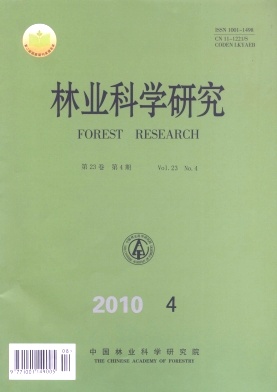Analysis on Microbial Flora and Dominant Populations in Three Types of Pinus massoniana Forests in Yunyang County of the Three Gorges Reservoir Area
Ⅰ. Bacteria, Bacillus and Fungi Species in Forest Land Soil
-
1.
Research Institute of Forest Ecology, Environment and Protection, Chinese Academy of Forestry, Beijing 100091, China
-
2.
Yunyang Forestry Bureau, Chongqing City,Yunyang 404500, Chongqing, China)
-
Abstract
To explore the soil microbial flora and their seasonal changes on different forest types of Pinus massoniana,the cultivable bacteria, Bacillus spp. and fungi in the soil of near-matured forest, middle-aged forest and plantation in Yunyang County of the Three Gorges Reservoir Area were analyzed. The results showed that the species of dominant populations and quantities of soil microbial in forest land soil were different following seasons vary and forest types. The quantities of bacteria in middle-aged forest was significantly higher than that in near-matured forest and plantation, and it changed greatly as seasons change, while the change in near-matured forest and plantation were relatively gentle. The dominant species of bacteria in forest land soil were mainly Bacillus spp.,Pseudomonas spp. and especially Bacillus cereus. The dominant bacterial population was the highest in the winter (near-matured forest> plantation> middle-aged forest), the dominant species in near-matured forest was Bacillus, accounting for 39.74%; that in plantation was Pseudomonas spp., 37.26%; that in middle-aged forest was Bacillus cereus, 24.91%. In the soil of the three types of forest land in different seasons, Bacillus cereus (20% to 49%) and one of the species (unidentification) of Bacillaceae were the dominant species. The dominant fungi species in the soil of the three forest types had the highest proportion in the autumn, and followed the order of plantation> near-matured forest > middle-aged forest; the dominant population and the percentage took in plantation, near-matured forest and middle-aged forest were respectively Sclerotinia sclerotiorum, 33.08%, Sclerotinia sclerotiorum, 31.7%, Penicillium waksmanii, 25.15%.
-

-
References
|
[1]
|
程东升.森林微生物生态学[M].哈尔滨:东北林业大学出版社,1993:300-329
|
|
[2]
|
张 猛,张 建.林地土壤微生物、酶活性研究进展[J].四川农业大学学报,2003,12:347-351
|
|
[3]
|
中国农业百科全书编辑部.中国农业百科全书(林业卷)[M].北京:农业出版社,1989:547-548
|
|
[4]
|
中国农业百科全书编辑部.中国农业百科全书(土壤卷)[M].北京:农业出版社,1996:388-390
|
|
[5]
|
王 岩,沈其荣,史瑞和,等.土壤微生物量及其生态效应[J].南京农业大学学报,1996,19(4):45-51
|
|
[6]
|
年士政. 森林微生物DNA分析技术及其应用[J].广州林业科技,2002,18(2):23-26
|
|
[7]
|
中国科学院南京土壤研究所.土壤理化分析[M].上海:上海科学技术出版社,1978:466-467
|
|
[8]
|
王守正,王海燕,李洪连,等.植物微生物区系和植物抗病性研究[J].河南农业科学,2001(5):20-22
|
|
[9]
|
张玉玲,黄 琼,汪安云,等.白肋烟晾制期间烟叶中细菌的分离和鉴定[J].中国烟草学报,2007, 13(1):37-40
|
|
[10]
|
罗 兰,袁忠林,陈 茎.小麦全蚀病菌拮抗细菌的筛选及鉴定[J].莱阳农学院学报, 2006,23(3):205-207
|
|
[11]
|
东秀珠, 蔡妙英. 常用细菌系统鉴定手册[M].北京:科学出版社,2001:353-398
|
|
[12]
|
布坎南R E,吉本斯 N E. 伯杰细菌鉴定手册 .中国科学院微生物研究所《伯杰细菌鉴定手册》翻译组译.北京:科学出版社,1984
|
|
[13]
|
魏景超. 真菌鉴定手册[M]. 上海:上海科学技术出版社,1979
|
|
[14]
|
Gardes M, Bruns T D. ITS primer with enhanced specificity for basidiomycetes: Application to the identification of mycorrhizae and rusts[J] .Mol Ecol,1993:113-118 |
|
[15]
|
张志华,洪 葵.核酸序列直接分析在真菌鉴定方面的应用[J].华南热带农业大学学报,2006,12(2):39-42
|
|
[16]
|
刘春来,文景芝, 杨明秀,等.rDNA-ITS 在植物病原真菌分子检测中的应用[J].东北农业大学学报,2007,38(1):101-106
|
|
[17]
|
李春义,马履一,徐 昕.抚育间伐对森林生物多样性影响研究进展[J].世界林业研究,2006, 19(6):27-31
|
|
[18]
|
焦如珍,杨承栋,屠星南,等.杉木人工林不同发育阶段林下植被、土壤微生物、酶活性及养分的变化[J].林业科学研究,1997, 10(4):373-379
|
|
[19]
|
盛炜彤,杨承栋,范少辉. 杉木人工林的土壤性质变化[J].林业科学研究,2003,16 (4):377-385
|
-
-
Proportional views

-





 DownLoad:
DownLoad: